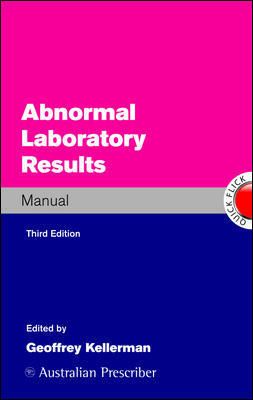Abnormal Laboratory Results Manual
3rd Edition
0070998426
·
9780070998421
© 2011 | Published: May 2, 2011
Abnormal Laboratory Results is a comprehensive collection of common abnormal test results which examine the dilemmas of abnormal tests and outlines how to approach them. Each test is analysed and interpreted in a structured, logical way and assessed …
Read More
Receive via shipping:
- Colour, print bound version of the complete text
Abnormal Laboratory Results
Foreword
Preface to the third edition
Contributors
Acknowledgments
1 What to do about abnormal laboratory results
2 Abnormal laboratory results
3 What does the reference range of a biochemical screen test mean?
4 Pitfalls in interpreting laboratory results
5 Moving beyond sensitivity and specificity: using likelihood ratios to help interpret diagnostic tests
6 Point-of-care testing comes of age in Australia
7 Urine testing
8 Plasma sodium
9 Serum potassium
10 Serum urea
11 Assessing renal function
12 Interpreting arterial blood gases
13 Calcium and vitamin D
14 Magnesium: the forgotten electrolyte
15 Hyperuricaemia
16 Liver function tests
17 Interpretation and significance of high blood cholesterol
18 Managing hyperlipidaemia: criteria for investigating lipids
19 New cardiac markers
20 B-type natriuretic peptide: a new diagnostic tool for congestive heart failure
21 Thyroid function tests
22 Evaluating adrenocortical function in adults
23 The glucose tolerance test
24 Diabetes monitoring: use of glycated haemoglobin and glycated protein assays
25 Fertility testing
26 Biochemical tests in pregnancy
27 Biochemical tests for abnormalities in pregnancy
28 Interpreting paediatric biochemistry results
29 Drug screens
30 Therapeutic drug monitoring: which drugs, why, when and how to do it
31 The red cells
32 Interpreting biochemical tests for iron deficiency: diagnostic difficulties imposed by the limitations of individual tests
33 Appropriate use of tests for folate and vitamin B deficiency
34 Screening for thalassaemia and haemoglobin variants
35 Investigations for thrombotic tendencies
36 Tests of haemostasis: detecting the patient at risk of bleeding
37 Abnormal haematology results in children
38 Hepatitis B: laboratory diagnosis and vaccination
39 Hepatitis C: laboratory diagnosis and monitoring
40 HIV testing in Australia
41 Testing for sexually transmitted infections
42 Testing for Helicobacter pylori
43 Screening for multiple myeloma
44 Testing cell-mediated immunity
45 Cell markers
46 Skin prick testing and in vitro assays for allergic sensitivity
47 Antinuclear antibodies (ANA)
48 Rheumatoid factor and anti-citrullinated peptide antibody
49 BRCA testing for familial breast cancer
Index
Foreword
Preface to the third edition
Contributors
Acknowledgments
Part 1 General Issues
1 What to do about abnormal laboratory results
2 Abnormal laboratory results
3 What does the reference range of a biochemical screen test mean?
4 Pitfalls in interpreting laboratory results
5 Moving beyond sensitivity and specificity: using likelihood ratios to help interpret diagnostic tests
6 Point-of-care testing comes of age in Australia
7 Urine testing
Part 2 Biochemistry Tests
8 Plasma sodium
9 Serum potassium
10 Serum urea
11 Assessing renal function
12 Interpreting arterial blood gases
13 Calcium and vitamin D
14 Magnesium: the forgotten electrolyte
15 Hyperuricaemia
16 Liver function tests
17 Interpretation and significance of high blood cholesterol
18 Managing hyperlipidaemia: criteria for investigating lipids
19 New cardiac markers
20 B-type natriuretic peptide: a new diagnostic tool for congestive heart failure
21 Thyroid function tests
22 Evaluating adrenocortical function in adults
23 The glucose tolerance test
24 Diabetes monitoring: use of glycated haemoglobin and glycated protein assays
25 Fertility testing
26 Biochemical tests in pregnancy
27 Biochemical tests for abnormalities in pregnancy
28 Interpreting paediatric biochemistry results
29 Drug screens
30 Therapeutic drug monitoring: which drugs, why, when and how to do it
Part 3 Haematology Tests
31 The red cells
32 Interpreting biochemical tests for iron deficiency: diagnostic difficulties imposed by the limitations of individual tests
33 Appropriate use of tests for folate and vitamin B deficiency
34 Screening for thalassaemia and haemoglobin variants
35 Investigations for thrombotic tendencies
36 Tests of haemostasis: detecting the patient at risk of bleeding
37 Abnormal haematology results in children
Part 4 Microbiology Tests
38 Hepatitis B: laboratory diagnosis and vaccination
39 Hepatitis C: laboratory diagnosis and monitoring
40 HIV testing in Australia
41 Testing for sexually transmitted infections
42 Testing for Helicobacter pylori
Part 5 Immunology Tests
43 Screening for multiple myeloma
44 Testing cell-mediated immunity
45 Cell markers
46 Skin prick testing and in vitro assays for allergic sensitivity
47 Antinuclear antibodies (ANA)
48 Rheumatoid factor and anti-citrullinated peptide antibody
Part 6 Genetic Tests
49 BRCA testing for familial breast cancer
Index
Abnormal Laboratory Results is a comprehensive collection of common abnormal test results which examine the dilemmas of abnormal tests and outlines how to approach them. Each test is analysed and interpreted in a structured, logical way and assessed in terms of its abnormal and normal reference range. The results are then presented in a variety of clinical contexts so an accurate prognosis and recommendations on management can be made. Each chapter was originally published as an article in the series titled Abnormal Laboratory Results by the journal Australian Prescriber
Key Features
13 completely new chapters All previous chapters updated PVC cover and two colour internals New Book: Abnormal Laboratory Results, Geoffrey Kellerman from McGraw-Hill Education ANZ- Medical
